Forever eye-catching and fashionable, white horses were often ridden by knights or gifted to royalty.
The most common white horse breeds are the Lipizzan, Camargue, Connemara, Boulonnais, and Shagya Arabian. Most of these breeds have been selectively bred over centuries for their unique white coat for owners to show off.
But are white horses really white? While this might seem like a rhetorical question, it’s a debate equestrian and laypeople often have.
As a matter of fact, true white horses are extremely rare. They are born and stay white throughout their lives and are usually dark-eyed with pink skin. What most people refer to as “white horses” are actually either gray or cream.
Below, we have gathered some beautiful horse breeds that display one of the three types of white coat colors.
Hare are 9 common white horse breeds:
Lipizzan
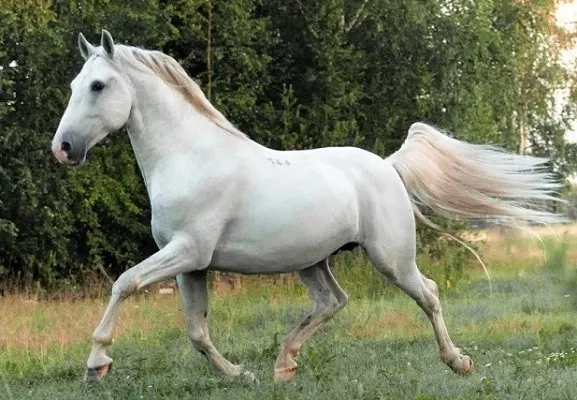
Au_Cr / Shutterstock.com
This white horse breed is famous for performing on the dressage shows of the Spanish Riding School in Vienna, Austria. Lipizzans not only make elegant riding horses but are also talented in carriage driving.
Gray is the dominant color in the Lipizzan breed, although bay and black horses also occur. Lipizzan foals are born black and whiten out over the years. They generally mature into a height of 14.2 to 16.1 hands.
The Lipizzan breed takes its name from the prestigious Lipizza Stud located in modern-day Slovenia. From the 18th century, Lipizzan horses were selectively bred to be gray as this was the preferred color of the Habsburg royal family.
This baroque-type breed is able to perform highly complex classical dressage moves. They can also be trained for haute école or “above the air” dressage, which is the most advanced form of classical riding.
Lipizzan horses are most popular in countries of middle and eastern Europe. Although they take longer to mature, Lipizzans are long-lived and can work well into their 20’s.
Camargue Horse
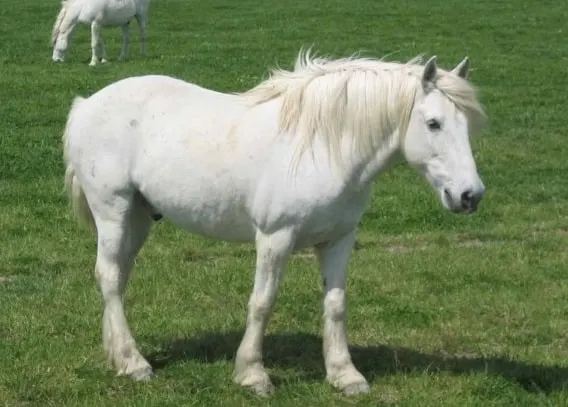
The Camargue is a unique white horse breed that roams the marshlands of Southern France. They are popular subjects of filmmakers and photographers, who are keen on capturing entire herds galloping through the water.
Camargue Horses are exclusively gray and become lighter as they age. They are hardy and agile with a short, compact body and a height range of 13.1-14.3 hands.
This native French breed has been living in the Camargue region for thousands of years. The Camargue Horse has stayed pure since prehistoric times and is possibly one of the oldest horse breeds still in existence. Over the centuries, they have influenced the development of several Spanish breeds.
The history of the Camargue Horse is closely intertwined with the cattle herders of the region known as “gardians”. They use Camargue mounts for the management of both cattle and semi-feral horses.
Due to their outstanding stamina and intelligence, Camargue Horses also excel in endurance riding and dressage. They regularly take part in traditional Camargue events such as the cattle-herding game “abrivado”.
American Cream Draft
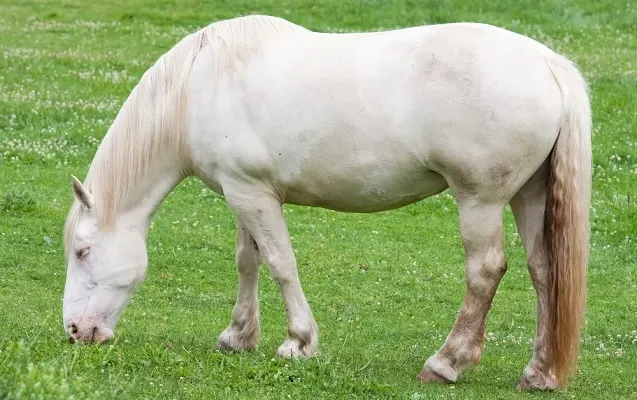
Nancy Kennedy / Shutterstock.com
Our next white horse breed is the American Cream Draft, known for its characteristic coat color and gentle temperament. Its light cream coloration is caused by a dilution in the chestnut base color triggered by the “champagne gene”.
American Cream Drafts can be anywhere from light to dark cream. All horses must have pink skin, amber eyes, and white manes and tails. They have a muscular body and stand between 15 to 16.3 hands.
The American Cream Draft is currently the only draft horse breed with origins in the United States. It dates back to one foundation mare called Old Granny who was born in Iowa around the early 1900s.
After the mechanization of agriculture in the early 20th century, the number of horses has dropped drastically. While numbers are still critical, several breeding programs have launched to save the breed from extinction.
Their agricultural role might have subsided, but American Cream Drafts also make fabulous carriage horses and often appear on shows and parades.
Connemara Pony
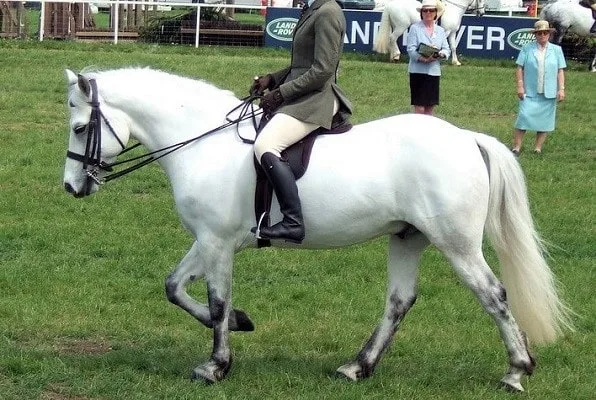
Lebatihem / Flickr
The Connemara is an Irish sports pony breed that is often gray in color. Intelligent and versatile, Connemara Ponies are most popular in the British Isles and the United States.
Although gray is the most common color in the breed, Connemaras can also be bay, brown, black, chestnut, palomino, or dun. They are the perfect riding pony with a well-proportioned body and are usually 12.2 to 15 hands tall.
The ancestors of the modern Connemara were likely the ponies of the Vikings. It is possible that the breed has had Spanish influence, alongside Arabian, Hackney, and Thoroughbred bloodlines.
Due to extensive crossbreeding, a breed society has opened in 1923 in order to protect and improve the original Connemara Pony. Also known as the national horse breed of Ireland, Connemaras have conquered the hearts of children and adults across the globe.
Its harsh natural habitat made this pony breed incredibly hardy and sure-footed. Hence, Connemaras not only do well in classical disciplines but also make great endurance and carriage driving.
Camarillo White Horse
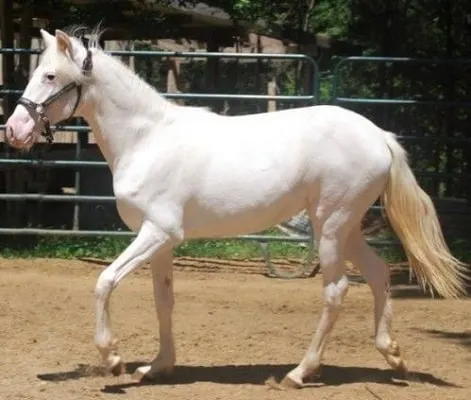
The only true white horse breed, the Camarillo White Horse is unique in every sense. The breed itself is merely 100 years old and very rare, with possibly less than 20 purebreds left!
Unlike gray horses, Camarillos are born white and retain their color throughout their lives. They also have pink skin and dark eyes, which are typical of a true white horse. Members of the breed are of a refined build, with strong limbs and expressive eyes.
All pure and crossbred Camarillo White Horses trace back to one founding stallion called Sultan. Adolfo Camarillo purchased the Mustang stallion in California and started developing the new breed in 1921. His family retained exclusive ownership of all Camarillo horses until 1987.
Four years later, there were only 11 Camarillo horses left, which prompted the formation of a breed association. The studbook for the breed remained open to allow for input from other breeds and avoid inbreeding.
Breeders of Camarillo White Horses must carefully consider genetics, as crossing two white horses carry a 25% chance of producing no live foal. To avoid this risk, breeders have been crossing white and non-white horses, resulting in at least half the foals being born white.
Shagya Arabian
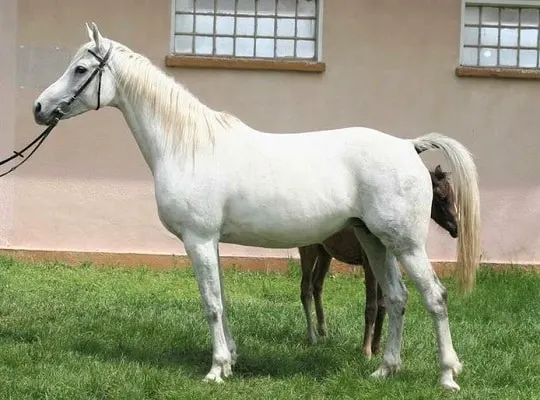
This white horse breed is classed as a part-bred rather than a type of Arabian as it also has non-Arabian breeding. Shagya Arabians are almost always gray and are excellent endurance athletes.
Learn about the other types of Arabian horses here.
Other than gray, members of the breed can also be black, bay or chestnut. They stand taller than an average Arabian horse, with a height of 15 to 16 hands. They also have a stronger bone structure, but still retain the typical looks of Arabian horses.
The breed takes its name from one of the founding stallions called Shagya, who was a purebred Arabian. It developed in the Austro-Hungarian Empire during the 1800s, when imported Arabian sires were crossed with local part-bred Arab mares.
The Shagya Arabian is most common in middle and eastern Europe but has also made it to countries around the world. In the past, they served as cavalry horses, but today are only used for recreation.
Shagya Arabians are popular sports horses worldwide, especially in three-day eventing and endurance. They are also a great choice for carriage driving.
Boulonnais Horse
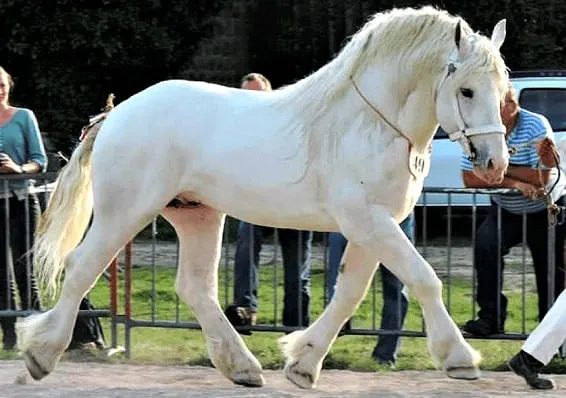
Also known as the “White Marble Horse”, the Boulonnais’ primary coat color is gray. This heavy French horse breed is famous for its remarkable elegance and refinement.
Boulonnais horses can be either gray, chestnut, or black. They stand between 14.3 to 16.3 hands in height and have a robust build with short legs and an elegant head.
Today’s Boulonnais Horses have inherited their fine looks from Andalusian, Arabian, and Barb bloodlines that merged with the breed in the 17th century. The Boulonnais itself has played an important role in the creation of several modern draft breeds such as the Italian Heavy Draft or the Ardennes.
During the two World Wars, the breed was a valuable asset to the French army where they pulled supply wagons and artillery. The end of the wars has also brought a sharp decline in the Boulonnais population and numbers have remained low ever since.
More recently, the French National Stud has developed a breeding program to create a faster and more agile Boulonnais driving horse. The program involves crossing Boulonnais horses with Arabians and also aims to bring new blood into the breed.
Percheron
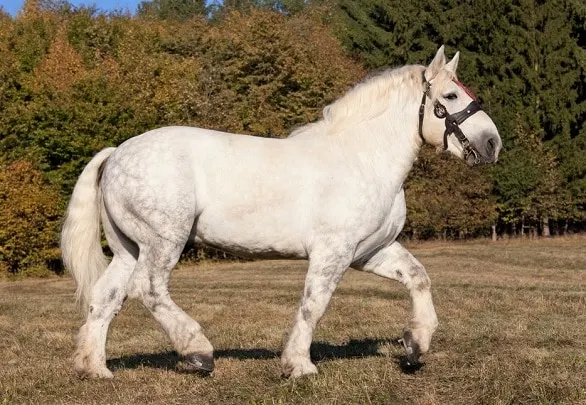
Lenkadan / Shutterstock.com
Another heavy white horse breed is the Percheron, the most well-known of all French draft breeds in the world. Elegant and agile, this giant horse breed does well both in harness and under saddle.
The official colors of the Percheron are gray and black. They range enormously in height, from 15 hands to a staggering 19 hands. Heavy feathering and excessive white markings are discouraged in the breed.
As mention in our war horse breeds guide, the Percheron dates back to 17th century France where it was primarily used in battle. After the decline of heavy cavalry, their role shifted to pulling coaches and draft work.
At the turn of the 19th century, the breed received an infusion of Arabian blood for extra refinement and endurance.
Today, Percherons are most popular in France and the United States, but they also occur in Britain and Australia. They still retain their uses in agriculture and forestry and also work in advertising.
Percherons have played a role in improving several draft horse breeds, such as the Ardennes or the Vladimir Heavy Draft. Their warmblood crosses make excellent competition horses and have been successful in the hunter/jumper and dressage ring.
Orlov Trotter
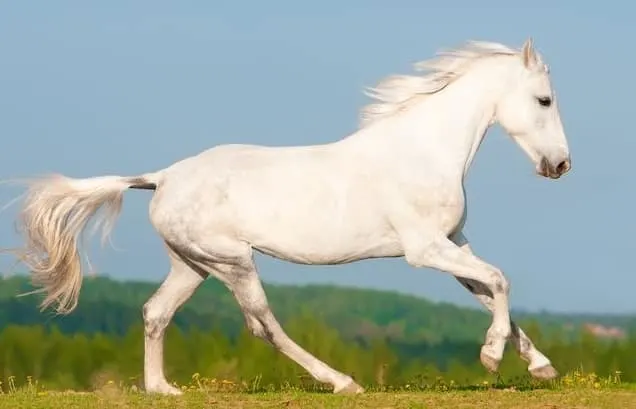
vikarus/123RF
The last white horse breed on our list is the Orlov Trotter, a predominantly gray Russian breed. They are taller and more refined than rival trotting breeds, although somewhat slower.
Almost half of all Orlov Trotters are gray in color but black, bay, and rarely chestnut horses also occur. Their average height is between 15.5 to 16 hands. Orlov Trotters have a muscular body with strong legs and tendons ideal for harness racing.
All modern Orlov Trotters trace back to a grey Arabian stallion called Smetanka, who lived in the 18th century. His offspring were crossed with mares from several European bloodlines to produce the graceful and hard-working Orlov Trotter.
Initially the pleasure horse of Russian nobility, the breed often received praise for its beauty and elegance. Several Russian horse breeds today have Orlov bloodlines in their ancestry.
As harness racing gained popularity, it became apparent that American Standardbreds outperform Orlov Trotters.
The frequent crossing of the two breeds resulted in near extinction of the Orlov Trotter. Luckily, numerous studs in Russia and Ukraine are now dedicated to preserving and improving this precious breed.
Also read:
6 Common Black Horse Breeds10 Most Popular Horse Breeds & Why They’re So Common7 Best Horse Breeds for Trail Riding10 Spotted Horse Breeds9 Best Dressage Horse Breeds12 Best Horse Breeds for Jumping
source: horseyhooves.com








